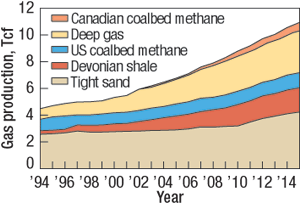What's new in production
Downhole power. Drilling always requires power, lots of engine power, torque and weight-on-bit to open a path for production. The industry’s challenge is to extend that capability deeper into more hostile environments, where temperatures and pressures press the capability envelope of even “dumb iron.” However, the industry doesn’t do a whole lot with solitary iron any more. Most drillstrings are instrumentation with MWD/LWD and other tools that ride behind the bit as part of the BHA to interrogate the rocks and report hole conditions to the surface. It is these instrumented tools that help the driller cut to the target in optimal time and identify drilling situations before they become problems. The tools are a great help, but come with certain tradeoffs. Most downhole tools operate on battery power, mainly lithium-ion (LI). For industry’s use, LI cells have the densest energy capacity of the main battery types: lead-acid, nickel-cadmium and nickel-metal hydride. Because LI energy density is twice that of NiCad cells, a single 3.6-volt cell can be constructed, instead of wiring three 1.2-volt cells in series. A single battery makes for easier tool construction, as well as improving reliability. Another LI advantage is low maintenance. It has no power-memory problem (hysteresis) and no need for scheduled cycling to prolong battery life. However, LI systems have limits imposed by temperature and charging capacity that require monitoring. Circuit protection limits LI’s downside voltage during discharge and limits the peak voltage it receives during charging. In short, LI needs a chipset onboard for safety; otherwise unstable metallic lithium can precipitate in the battery and create a fire hazard, not a pleasant thought at the wellsite. For very deep wells, the instrumented BHA is critical, but battery life and higher temperatures constrain their use and force multiple trips to change out tools or batteries well ahead of bit replacement. Much research is underway to overcome these limits. A recent press release by Sondex and Beta Research and Development announcing UK Department of Trade and Industry funding to develop new rechargeable, high temperature batteries, shows that there is a future need for better, more durable batteries to extend downhole instrument capability. The Drilling Engineers Association, a research-operations forum of IADC, initiated a joint industry project in October 2003, DEA-153: Honeywell Deep Trek High Temperature Electronics, to overcome the short life of electronic control circuitry above 175°C. The four-year JIP is well on its way to extending electronic component tolerances beyond 200°C. Once this is achieved, it will open the way to more robust tools and deeper, longer, instrumented drilling times. It may also extend the life of LI battery control circuits and provide extended life for tools that operate in more friendly pressures and temperatures.
If only there were a way to feed the tools the energy they need for the full run of the bit. This is the larger goal: to minimize the number of trips required to service the tools on deep, hot wellbores. Deep wells are at the edge of the operational envelope and where the industry expects much of the future’s natural gas to be found. Work is underway on the HPHT power problem and several ways to generate continuous downhole power are under development. Before battery technology provided electric power downhole, the industry used various forms of downhole generators in the drillstring. These are still available and used throughout conventional temperature and pressure ranges. Researchers are examining the downhole generator again with the goal of producing one that will be reliable at over 20,000 psi and above 250°C. Such a device would overcome the need to trip pipe for battery changes and move toward the goal of a full bit run before tool change-out. The DEA has opened a discussion item, DI-114: Development of an Advanced High Temperature High Pressure Downhole Power Supply. Initiated by Dexter Magnetic Technologies, the envisioned tool would be based around a mud-driven turbine. DMT has an existing downhole turbine generator for conventional temperatures and pressures that converts a small portion of linear mudstream power to rotation, which then drives the generator. The device proposed will need improved circuitry and pressure housings to protect the magnetic coupling. No lab facilities are available for testing at 20,000 psi and 250°C, so prototypes will be run in HPHT environments during development. While turbines are an established technology, they are not the only way to generate power from the mud column. Halliburton is working on an unusual device that helps overcome a downhole problem, vibration, while generating power for drillstring tools. The idea is to use existing positive displacement motor technology as the energy source to activate piezoelectric crystals imbedded in the internal rubber elements. The spinning of the mud-motor’s shaft presses and stresses the rubber element, which then distorts the piezoelectric crystals. When the crystals return to their normal state they release electrons that can be gathered and stored to run tools. This effectively captures energy that is now producing vibration in PDMs. By harvesting this “wasted” energy, motor vibration could be damped, electric energy would be gathered and a steady energy stream would drive downhole tools for the full bit run. The oil industry continues to press its operational envelope and address the challenges that come with each deeper step. Developing improved downhole power sources will take the bit deeper faster than ever before.
|
|||||||||||
- What's new in production (February 2024)
- Prices and governmental policies combine to stymie Canadian upstream growth (February 2024)
- U.S. operators reduce activity as crude prices plunge (February 2024)
- U.S. producing gas wells increase despite low prices (February 2024)
- U.S. drilling: More of the same expected (February 2024)
- U.S. oil and natural gas production hits record highs (February 2024)





